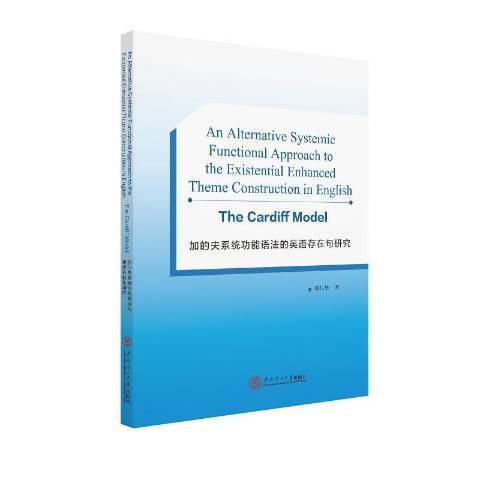內容簡介
《加的夫系統功能語法的英語存在句研究》的主要內容包括:
(1)存在句的類型;
(2)存在句的基本句法特徵;
(3)如何對不同類型的存在句進行句法—語義分析;
(4)哪些成分可充當存在型強勢主位及如何將它們建構成一個存在型強勢主位系統;
(5)存在句中的“存在”意義可由哪些動詞體現及如何運用韓禮德把“辭彙當作精細的語法”的思想來系統描述這些動詞;
(6)存在句具備哪些語篇功能及其不同的語篇功能與不同的體裁的語篇之間的關係如何。
作者簡介
鄧仁華,博士。2006年12月獲中山大學英語語言文學專業博士學位,師從黃國文教授。現為華南理工大學外國語學院副教授、碩士研究生導師、中國英漢語篇分析研究會會員、中國功能語言學研究會會員、廣東省外國語言學會理事。主要研究方向為功能語言學、文體學、語篇。
圖書目錄
List of Figures
List of Abbreviations
Chapter 1 Introduction
1.1 Types of enhanced theme constructions
1.2 The existential enhanced theme construction
1.2.1 "The EET construction" as a choice
1.2.2 Four types of EET constructions
1.3 Theoretical orientation
1.4 Objectives and research questions
1.5 Terms used in other studies
1.6 Data and methodology
1.7 The organization of the book
Chapter 2 A Review of Previous Studies
2.1 Introduction
2.2 Traditional descriptive approaches
2.2.1 Jespersen (1937/1984, 1945/1965)
2.2.2 Bolinger (1977)
2.2.3 Quirk and Greenbaum (1973) and Quirk et al.(1985)
2.2.4 Huddleston (1984, 1988)
2.2.5 Biber et al.(1999/2000)
2.2.6 Huddleston and Pullum (2002)
2.3 Generative grammar approaches
2.3.1 Chomsky (1981)
2.3.2 Lumsden (1988)
2.3.3 Chomsky (1995)
2.3.4 Han (2001)
2.3.5 Tang (2001)
2.4 Functional approaches
2.4.1 Scottetal(1968)
2.4.2 Dik (1980, 1981)
2.4.3 Hannay (1985)
2.4.4 Young (1980)
2.4.5 Morley (2000)
2.4.6 Kuno and Takami (2004)
2.5 The Madrid Grammar approach
2.6 Concluding remarks
Chapter 3 The Existential Enhanced Theme Construction: Towards a Theory-Neutral Description
3.1 Introduction
3.2 Basic characteristics of the construction
3.2.1 There
3.2.2 The Main Verb
3.2.3 Subject-verb agreement and a tentative account
3.2.4 The postverbal nominal group
3.2.5 The post-ngp element
3.3 Summary and conclusion
Chapter 4 The Theoretical Framework
4.1 Introduction
4.2 Systemic functional grammar
4.2.1 Scales and categories
4.2.2 System and system network
4.2.3 Metafunctions and semantic networks in the Sydney Grammar
4.3 The Cardiff Grammar
4.3.1 History background
4.3.2 The main components in the Cardiff Grammar
4.3.3 Semantic system networks in the Cardiff Grammar
4.3.4 Realization rules
4.3.5 Form: realization in syntax
4.4 Concluding remarks
Chapter 5 An Alternative Systemic Functional Approach
5.1 Introduction
5.2 The Sydney Grammar approaches
5.2.1 Halliday's approach
5.2.2 Matthiessen (1995)
5.2.3 Downing and Locke (1992)
5.2.4 Thompson (1996/2000) and Huang (1997, 1999)
5.3 The Cardiff Grammar approach
5.3.1 The experiential meaning of the EET construction
5.3.2 Fawcett's syntactic-semantic analysis and minor adjustments
5.3.3 Two existential enhanced theme analyses
5.4 The thematic options in the EET construction
5.5 The relationship to the non-enhanced version
5.6 The syntactic-semantic analysis of different types of EET constructions
5.6.1 The locational EET construction
5.6.2 The attributive EET construction
5.6.3 The directional EET construction
5.6.4 The possessive EET construction
5.7 Summary and conclusions
Chapter 6 The Semantics of the Verbs in the EET Construction
6.1 Introduction
6.2 Lexis as "most delicate grammar"
6.3 The exploration of the grammarian's dream
6.3.1 Berry (1977)
6.3.2 Fawcett (1980, 1987)
6.3.3 Hasan (1987)
6.3.4 Cross (1992)
6.3.5 Tucker (1996, 1998)
6.4 The semantics of the verbs in the EET construction
6.4.1 Previous classifications
6.4.2 The systemic representation of the verbs in the construction
6.5 Concluding remarks
Chapter 7 Discourse Functions
7.1 Introduction
7.2 Huang's taxonomy and Zhang's "system"
7.3 The discourse functions
7.3.1 The initiation function
7.3.2 The continuation function
7.3.3 The concluding function
7.3.4 The correction function
7.4 Concluding remarks
Chapter 8 Summary and Conclusions
8.1 Introduction
8.2 The main arguments
8.2.1 Systemic functional orientation
8.2.2 A tentative account
8.2.3 Challenging the restrictions in the EET construction
8.2.4 Four types of EET constructions
8.2.5 The expanded network of existential enhanced theme
8.2.6 The semantics of the verbs in the EET construction
8.2.7 Discourse functions
8.3 Follow-up research
8.4 Concluding remarks
References

